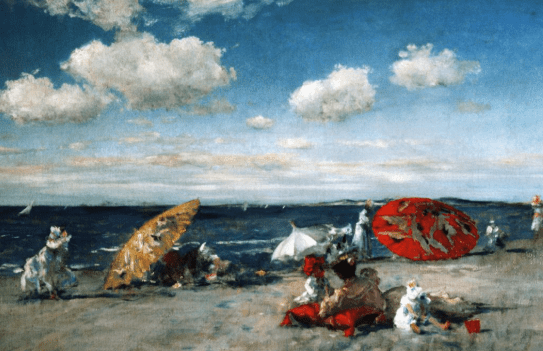Hamptons Art is more than a three-syllable term—it’s a brand. Beyond geography, it defines a rare intersection of real estate and cultural capital. Here, the ocean breeze carries not only the scent of salt but also the whisper of stratospheric valuations. To understand the art history of this coast is, therefore, to grasp a deeper economic truth: sometimes, the most priceless assets begin as liabilities. Moreover, when genius is properly leveraged, it can anchor an entire luxury market.
Yet this isn’t a story of pastoral escape. Rather, it’s a chronicle of strategic cultural acquisition—where artists, initially drawn by solitude and light, unintentionally built the foundation for a real estate empire. Over time, their creative refuge evolved into a marketplace of myth and exclusivity, proving that in the Hamptons, beauty is never accidental; it’s an investment that appreciates in every sense.
The First Market Makers: Impressionism’s Gilded Edge
Before the drip, before the pop, there was the light. And where there was unique light, there was opportunity. Enter William Merritt Chase, a man who understood branding before the term existed. In 1891, he didn’t just open an art school in Shinnecock Hills; he opened a franchise of sophistication. He monetized the landscape.
Chase was a visionary of market development. He took the Hamptons—then a mere coastal stretch—and imbued it with a pedigree of artistic legitimacy (MFA Reference). He curated an experience. Teach society women to paint the dunes, and suddenly, the dunes themselves become desirable. It was an early, brilliant instance of cultural arbitrage, translating natural beauty into aspirational value. His school didn’t just teach painting; it taught the emerging American elite where to be—and by extension, what to own. The Hamptons, post-Chase, was no longer just land; it was a lifestyle product, pre-approved by the arbiters of taste.
The Prospectus: High Risk on a Windswept Shore
In the post-war era, a radical new venture opened on the isolated backroads of the Hamptons. Its founders—a group of artists decamping from New York City—were not following a proven business model. They were betting everything on a disruptive, unproven product: Abstract Expressionism. Their prospectus was blank canvas; their initial investment was sheer, unadulterated output in the face of market indifference. This was the original, high-risk art investment, headquartered in the dilapidated barns and modest homes of Springs.
Jackson Pollock’s operation was the fund’s most volatile holding. His drip paintings were a radical departure from the artistic blue-chips of the past, a high-risk technical innovation. His presence in Springs was initially seen as a liability, a bohemian squat that represented a negative externality. Beside him, Lee Krasner’s work was a critical but often overlooked part of the portfolio, her value eclipsed by Pollock’s supernova performance. Willem de Kooning’s later move to East Hampton was a strategic acquisition, a bet that the local environment itself—the light, the space—could be a tangible asset for inspiration. At this stage, there were no guarantees, only the immense risk of total failure.
The Payout: From Negative Externality to Billion-Dollar Equity
The gamble paid off with a return that redefined the entire art market. What began as a high-risk venture matured into the most robust cultural equity of the 20th century. The artists’ initial defiance became the foundation of a multi-billion dollar asset class.
Jackson Pollock’s barn, once a symbol of his rejection of the market, is now a hallowed site. Its immense cultural and real estate value is a direct dividend of the aesthetic revolution he unlocked, with institutions like the National Gallery of Art now managing the blue-chip stock he generated (NGA Reference). Lee Krasner’s legacy appreciated with such resilience that it ultimately stabilized the entire fund. The Pollock-Krasner Foundation, which dispenses grants to artists, is a perpetual philanthropic trust born from the very assets created in that humble Springs home (Pollock-Krasner Foundation Reference). This is pure, long-term capital appreciation from a foundational holding. Willem de Kooning’s East Hampton chapter, infused with the coast’s unique energy, became a peak in his career. They started with nothing but vision; they ended up becoming the market itself.
The Ultimate Leveraged Buyout: Pop Hamptons Art Celebrity Dividend
If the Abstract Expressionists were the accidental venture capitalists of culture, the Pop artists were the conscious private equity players. They understood that celebrity was the ultimate collateral. And the Hamptons, by the 1970s, was ripe for a leveraged buyout of its bohemian soul.
Andy Warhol didn’t just buy a house in Montauk; he bought a cultural beacon. His estate, Eothen, became a nexus for the era’s elite. A perpetual photo opportunity, a generator of myth, and the ultimate objet d’art in itself. Warhol’s art blurred the lines between commerce and creation. His Hamptons Art residency embodied this ethos physically. His soup cans and silk-screens, enshrined at The Andy Warhol Museum, confirm that in the Hamptons, even a celebrity sighting was a form of currency (Warhol Museum Reference). He understood that being seen there was as important as creating there.
And then there was Roy Lichtenstein, whose calculated, graphic mastery of the everyday was the comic strip panel and the ad man’s pitch. They found a knowing home in Southampton. His dot matrix aesthetic, now meticulously catalogued in a complete catalogue raisonné, reflected the Hamptons. It’s own carefully constructed artifice (Lichtenstein Catalogue Raisonné Reference). He captured the veneer, the surface perfection, that would come to define the modern Hamptons’ allure.
Hamptons Art is not just where great art was made; it is a living museum of cultural economics. It proves that the intangible value of artistic innovation, when incubated in a specific environment, can compound into an enduring, undeniable, and often astronomical market valuation. The luxury here isn’t just in the square footage or the ocean frontage; it’s in the provenance—the verifiable, undeniable lineage of genius that consecrated every acre. This isn’t just history; it’s the ultimate balance sheet of prestige. https://sociallifemagazine.com/art/11389/
